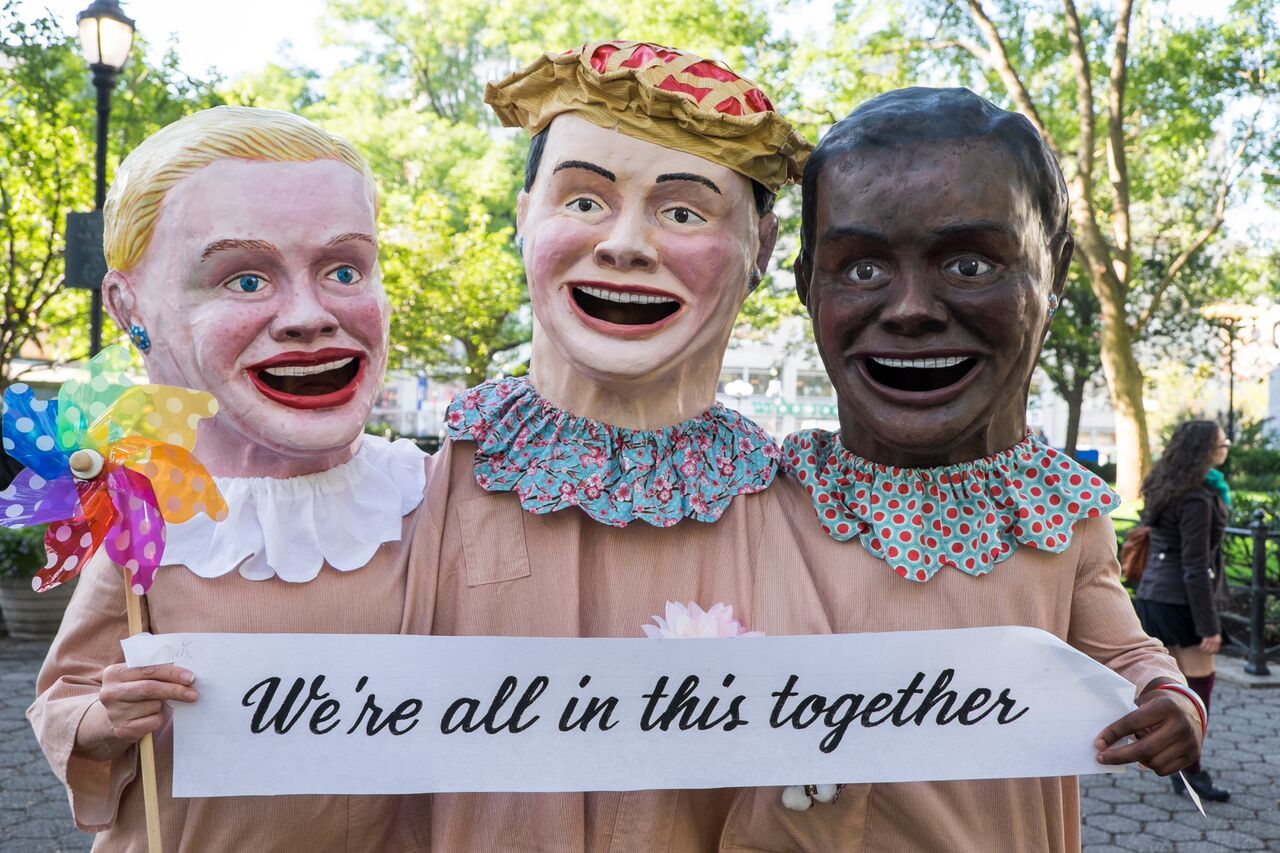Myrna Stone
Flamingos in the Men's Room
—after a photo of fifty live flamingos, taken at Miami
Metrozoo on September 25th, 1998, as Hurricane
Georges advances
Birds of a feather they may be
but each one cranes its neck to see
above their perfect conga lines
its own odd head so well aligned
in dual bright-lit glass above
the wall's enamel sinks. Doves
they're not, this cheeky funky troupe
of stilty-legged performing kooks
who, sheltered from Georges' play,
are stars of this poème à clef.
Still, their shade's a bit unzipped,
a tropics-hot Brazilian pimp
sort of pink that Nature lovers
relish, though these zoo dwellers
are not in fact one's stock Chilean
but are, instead, pure Caribbean.
Enrapt, they gawk and honk and clack
their bills, they dip and bob and quack.
Along the floor's straw-strewn tiles
they jig among the rank urinals
while miles and miles Bahamian way
a hundred-strong flamboyance sways
inside the salt-pan shallows of Great
Inagua Island. But both flock's fate
will play it safe, though some birds
growl and spit and gabble while turds
and turns and preeners proliferate,
and all of them squawk and bait
as some fly and others wait.
They flash their black underfeathers
and pay no heed to our foul weather.
They prance and pout and fluff and flout
and lark and lark and lark about.
Siglinda Scarpa's House of Cats
Though she is no sly agent of seduction,
nor pied, they fasten to her like the children
of Hamlin once fastened to a piper's tune,
heedless of all but their own thralldom
in coming to heel. Yet unlike children,
cats have nine lives, we are told, nine laps
upon their curious track about the wildering
world. Under sun and moon they fasten
to her like cockleburs fasten to fur. At seven,
and mostly silent, she engaged with a tabby
who prompted her to talk. I had to explain
to my mother, she confesses, what Kitty
was saying. I think I was a little autistic,
but there was no name for it then. Neither
was there one for the effect of Kitty's slick
tricks for attention that daily eased her
long lonely childhood in wartime Italy.
Now, at her sky-blue fairy house, hidden
in North Carolina woodland, her cats freely
exit and enter the open doors as she bids
them ciao and addio. They and all the other
tenants of her heart—eight dogs, bevies of
songbirds, two goats, and an Appenzeller
chicken—are her never-ending causa
famosa. But it is the cats she memorializes
in her ceramic art: Asthmatic Rosa, Deaf Tig,
Walt the Mute, and Gibson Oft in Mourning.
And one day soon, she says, like the twig
end of a branch, she will snap and be buried
beneath her broadest oak's tracery of leaves
where many of her dearest dead still tarry,
for this is her home, and they her babies.
|
|
 |
 |
| AUTHOR BIO |
| Myrna Stone is the author of five books of poems, the most recent being Luz Bones, released by Etruscan Press in 2017. A two-time Ohioana Book Award Finalist, her work has appeared in over fifty journals including, among others, Poetry, Southwest Review, The Massachusetts Review, Boulevard, Nimrod, and River Styx. Among her awards are three Ohio Arts Council Grants, a full fellowship to Vermont Studio Center, the 2001 Ohio Poet of the Year award, and the 2017 New Letters Prize in Poetry. Stone is a founding member of The Greenville Poets, based in Greenville, Ohio.
|
|
| POETRY CONTRIBUTORS |
 Barbara Crooker Barbara Crooker
 Alexandra Donovan Alexandra Donovan
 Jehanne Dubrow Jehanne Dubrow
 Kathleen Goldbach Kathleen Goldbach
 Colleen S. Harris Colleen S. Harris
 Brittany Hill Brittany Hill
 Katherine Hoerth Katherine Hoerth
 Lynne Knight Lynne Knight
 Jean L. Kreiling Jean L. Kreiling
 Angie Macri Angie Macri
 Carolyn Martin Carolyn Martin
 Kathleen McClung (Featured Poet) Kathleen McClung (Featured Poet)
 Mary Mercier Mary Mercier
 Ann Michael Ann Michael
 Leslie Schultz Leslie Schultz
 Myrna Stone Myrna Stone
 Jean Syed Jean Syed
 Ann Christine Tabaka Ann Christine Tabaka
 Sally Thomas Sally Thomas
 Doris Watts Doris Watts
 Joyce Wilson Joyce Wilson
 Marly Youmans Marly Youmans
|
|
|
 |
|
 |
|
|
|
 |
| Megan Marlatt:Looking like large puppet heads, it was "anima", the root of "animation", that led me to the making of the big heads, (or "capgrossos" as they are called in Catalonia where I learned the craft.) Anima is the soul or what breathes life into a being and to animate an inanimate object, an artist must insert a little soul into it. However to bring attention to what is invisible, (the soul), I chose to mold its opposite in solid form: the persona, the ego, the big head, the mask. Nearly every culture across the globe has masks. They allow performers to climb into the skin of another being and witness the other's world from behind their eyes. While doing so, the mask erases all clues of the performer's age, gender, species or race. In this regard, I find them to be the most transformative and empathic of all human artifacts.
|
|
|
|
|
|
 |
|
 |
|
|
|
|
